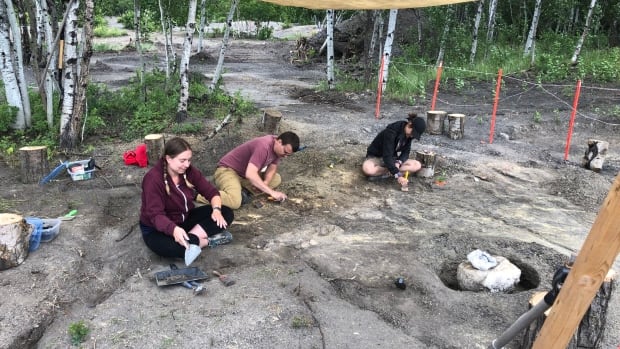[ad_1]
Researchers in southern Manitoba have made the rare discovery of what may be a complete fossilized skeleton belonging to a roughly 83-million-year-old marine reptile.
Excavations are still ongoing, but scientists have uncovered roughly 75 per cent of a mosasaur skeleton near the small community of Miami, Man., about 110 kilometres southwest of Winnipeg.
Finding such an intact skeleton is rare, according to Adolfo Cuetara, the executive director of the Canadian Fossil Discovery Centre in Morden, about 20 kilometres southeast of Miami.
“Normally you’re only finding isolated bones, but this time it looks like we have a whole skeleton,” he said in an interview with Radio-Canada on Monday.
In early July, a technician with the centre found a small bone while digging with a tractor on a plot of land that used to be a bentonite mine, and which the Morden organization purchased in 2004.
Finding small bones isn’t unusual, Cuetara said, but using hand tools, that technician soon realized that the bone was not an isolated discovery.
Over the next several days, the team found 15 vertebrae, all from the same marine reptile, Cuetara said.
Mosasaurs lived during the Late Cretaceous (100 million to 66 million years ago), a period at which Manitoba was underwater.
Rare conditions have to be met for entire skeletons to be fossilized, Cuetara said.
The body needs to be buried quickly in sediment to avoid contact with oxygen and bacteria, which break down the bones over time.
“Normally when animals die, the flesh is decomposed and the bones are moved by predators or scavengers or even currents, so that’s why most of the times we are finding just isolated pieces,” Cuetara said.
Staff from the Morden fossil centre believe this mosasaur, which is between six and seven metres long, is smaller than other mosasaurs found in Manitoba. The biggest is the mosasaur at the Morden centre nicknamed “Bruce,” which measures 13 metres.
The reptiles grew up to 16 metres long.

Once the entire skeleton is exposed, staff will take samples of the surrounding terrain and bring everything back to the lab.
When that process is complete, a paleontologist will study each bone, measure them and compare them to other species to identify the exact species.
“It’s a process that takes normally years to do if you want to do it properly,” Cuetara said.
[ad_2]
Source link




